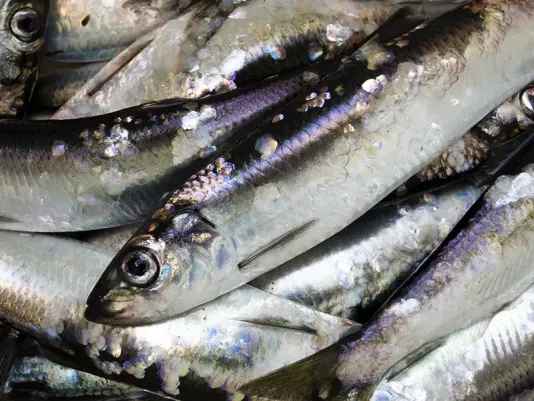Sandwich with Baltic Herring and Pickled Onions
Sandwich with baltic herring and pickled onions - a recipe from Swedish cuisine, a fragrant and spicy sandwich made from black bread.

Baltic Herring is a sea fish from the herring family, which I appreciate for its natural tenderness and simplicity in handling. It’s small but has firm flesh that doesn’t fall apart during cooking. Over years of practice, I’ve learned that the secret to good Baltic herring lies in the right balance of salt, temperature, and time. Fresh fish should have a clean sheen, clear eyes, and a light sea scent with no hint of sourness. I always buy it chilled rather than frozen, since even brief refreezing removes that delicate texture so pleasant in the finished dish. It’s a universal product: it can make both a light appetizer and a hearty dinner. Baltic herring adapts well to various techniques – from hot smoking to marinating in wine vinegar – while remaining tender, aromatic, and natural.
When choosing Baltic herring, I always look for several signs: shiny skin, firm body, and clear eyes. If the surface is dull or slimy, the fish has already lost its freshness. It’s best to buy herring in the morning, when the catch is still cold, not midday. I store it for no more than two days in the refrigerator at around 0-2°C (32-36°F), wrapped in parchment or lightly salted to prevent moisture buildup. I buy frozen herring only when necessary, always checking the ice clarity: if there are crystals, it’s a sign of refreezing. Over the years, I’ve noticed that fresh fish is easier to clean and has no bitterness in the belly. It’s also important not to store it near products with strong odors, as herring meat quickly absorbs foreign aromas. During transport, I use a cooler or ice but never place the fish directly on it – doing so may damage its texture. With a few simple habits, you can always have a product that preserves its natural flavor and texture.
Before cooking, I carefully clean the herring of scales and remove the gills right away, as they give an unpleasant taste when fried. A small knife or kitchen scissors works best for this. I rinse the belly with cold water, avoiding prolonged contact – otherwise, the flesh becomes watery. If I plan to marinate it, I pat it dry with a paper towel and leave it in the refrigerator for 30-40 minutes so the surface slightly dries out. This helps salt and spices penetrate the muscle fibers better. In my experience, proper preparation matters more than the cooking method itself: even the best pan won’t save the fish if it’s wet or uncleaned when placed on it. For stuffing or baking, I sometimes leave the head – it adds expressiveness, especially when serving the whole fish. However, for pan-frying, it’s better to remove the head to ensure even cooking. It’s also important to check the internal cavity for any residue or clots, as they quickly turn bitter when heated.
Baltic herring requires careful temperature control. Over medium heat, it cooks quickly – about 2–3 minutes per side until golden brown. If the heat is too high, the skin will burn while the inside remains raw. For baking, the optimal temperature is 180°C (356°F), which keeps the fish juicy and intact. For marinating before hot smoking, I keep the herring in brine for no more than six hours, as prolonged salting makes it tough. I often use a grill or convection oven – it allows me to get crisp skin without excess fat. While frying, it’s important not to flip the fish repeatedly: one careful turn with a spatula is enough. When cooking in batches, I cover the first portion with foil to keep it warm. From experience, the best result comes from combining short heat treatment with preliminary marination in an acidic medium – such as lemon juice or dry white wine. This adds tenderness and removes any excessive sea odor.
Baltic herring has a pronounced marine flavor, so I always use spices sparingly. Lemon, dill, parsley, black pepper, and a splash of white wine enhance it best. Too many spices can overpower the fish’s natural delicacy. For cold appetizers, I make light sauces – such as yogurt with mustard and finely chopped cucumber. This adds freshness and highlights the fish’s subtle saltiness. When preparing hot dishes, I use butter with a touch of lemon juice – it softens the texture and deepens the aroma. Sautéed onions also work well in warm dishes, adding a hint of sweetness. In my experience, the balance of acidity, fat, and tender protein always yields a harmonious result. If I plan to serve the fish with a side, I choose boiled potatoes, rice, or a simple fresh vegetable salad – they don’t overshadow the main flavor. The key is to avoid heavy sauces based on tomatoes or mayonnaise, which can make the fish less expressive.
The most common mistake when cooking Baltic herring is overdrying. Because of its small size, it loses moisture quickly, so cooking time must be monitored down to the minute. Another frequent issue is oversalting: salt in marinades or coatings should be moderate; otherwise, the fish will lose its natural sweetness. I always check the pan temperature before placing the first fish – if the fat doesn’t sizzle, the surface is still too cold and the fish will stick. Another mistake is insufficient cleaning: leftover scales can taste bitter after frying. When baking in the oven, it’s important not to cover the fish tightly with foil, as it will lose its crisp skin. If the fish is meant for later storage, such as in a marinade, I use glass rather than metal containers to avoid oxidation. And most importantly – don’t rush the serving: even a few minutes of resting after cooking allow the flesh to stabilize, firm up, and develop a more balanced flavor.